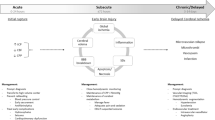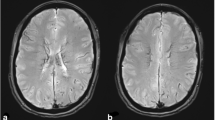Abstract
Pediatric stroke and transient ischemic attack (TIA) are uncommon but true emergencies with a wide differential diagnosis. Diagnostic imaging plays a critical role in differentiating the diverse range of etiologies. In this case, we report a 3-year-old female with no medical history who developed acute neurological deficits and demonstrate how adjunct advanced imaging including susceptibility weighted imaging (SWI) and pseudo-continuous arterial spin labeling (pCASL) can play a significant diagnostic role in the emergent setting. Imaging was performed with a Philips Ingenia 3.0T MRI. MRI brain, MR angiography (MRA), and phase contrast angiography MR Venography (PCA-MRV) were obtained. pCASL and SWI sequences were performed using SENSE (sensitivity encoding) parallel imaging techniques. MRI/MRA brain showed no restricted diffusion, abnormal T1/T2/FLAIR signal, arterial occlusion, or irregular angioarchitecture. SWI revealed increased susceptibility along the posterior falx cerebri and right posterior parietal and occipital lobes, and pCASL showed decreased blood flow within these same regions. No falcine sinus was visualized on PCA-MRV, but SWI and pCASL findings led to diagnosis of falcine sinus thrombosis and initiation of appropriate treatment. Repeat MRI one month later showed interval resolution of the abnormal SWI findings and a now patent persistent falcine sinus visualized on PCA-MRV imaging. Routine use of SWI imaging on all brain MRIs and addition of pCASL imaging when there is concern for ischemia or infarction in the emergent setting can limit the risk of missed occult diagnoses like a thrombosed falcine sinus.

Similar content being viewed by others
Data availability
Not applicable.
References
Khalaf A, Iv M, Fullerton H, Wintermark M (2018) Pediatric stroke imaging. Pediatr Neurol 86:5–18
Smith A, Choudhary A (2014) Prevalence of persistent falcine sinus as an incidental finding in the pediatric population. Am J Roentgenol 203:424–425
Lee I, Leach J, Tomsick T, Flaherty M (2015) Pearls & Oysters: cerebral venous sinus thrombosis involving a persistent falcine sinus. Neurology. 85(22):162–164
Mirsky D, Beslow L, Amlie-Lefond C (2017) Pathways for neuroimaging of childhood stroke. Pediatr Neurol 69:11–23
Lin L, Lin J, Guan J et al (2018) Falcine sinus: incidence and imaging characteristics of three-dimensional contrast-enhanced thin-section magnetic resonance imaging. The Korean Society of Radiology 19(3):463–469
Ryu C (2010) Persistent falcine sinus: is it really rare? Am J Neuroradiol 31:367–369
Meoded A, Poretti A, Benson J et al (2014) Evaluation of the ischemic penumbra focusing on the venous drainage: the role of susceptibility weight imaging (SWI) in pediatric ischemic cerebral stroke. J Neuroradiol 41:108–116
Havsteen I, Willer L, Ovesen C, Nybing JD, Ægidius K, Marstrand J, Meden P, Rosenbaum S, Folke MN, Christensen H, Christensen A (2018) Significance of arterial spin labeling perfusion and susceptibility weighted imaging changes in patients with transient ischemic attack: a prospective cohort study. BMC Med Imaging 18:24
Zaharchuk G, Olivot J, Fischbein N et al (2012) Arterial spin labeling imaging findings in transient ischemic attack patients: comparison with diffusion- and bolus perfusion-weighted imaging. Cerebrovasc Dis 34(3):221–228
Qiao X, Salamon N, Wang D, et al. Perfusion deficits detected by arterial spin labeling (ASL) in TIA Patients with Negative Diffusion and Vascular Imaging
Author information
Authors and Affiliations
Corresponding author
Ethics declarations
Conflict of interest
The authors declare that they have no conflict of interest.
Ethics approval
This report was approved by the author’s institution’s authored works component of the Directorate of Quality Management for submission for publication as a CASE REPORT/SERIES, #2413.
Consent to participate/for publications
This work was determined to be HIPAA compliant by the author’s institution’s authored works component of the Directorate of Quality Management for submission for publication. As such, consent to participate was not required for the present case report as all information and images are anonymized.
Disclaimer
The contents of this publication are the sole responsibility of the authors and do not necessarily reflect the views, opinions or policies of the Department of the Navy, the Department of Defense (DoD), or the US Government. Mention of trade names, commercial products, or organizations does not imply endorsement by the US Government.
Copyright statement
The authors are military service members or employees of the US Government. This work was prepared as part of their official duties. Title 17 U.S.C. §105 provides that “Copyright protection under this title is not available for any work of the United States Government.” Title 17 U.S.C. §101 defines a US Government work as a work prepared by a military service member or employee of the US Government as part of that person’s official duties.
Code availability
Not applicable.
Additional information
Publisher’s note
Springer Nature remains neutral with regard to jurisdictional claims in published maps and institutional affiliations.
Rights and permissions
About this article
Cite this article
Spiro, J.D., James, W.F. & Cho, A.A. Utility of susceptibility weighted imaging (SWI) and pseudo-continuous arterial spin labeling (pCASL) in diagnosis of falcine venous thrombosis in a child with transient ischemic attack. Emerg Radiol 28, 683–686 (2021). https://doi.org/10.1007/s10140-020-01882-2
Received:
Accepted:
Published:
Issue Date:
DOI: https://doi.org/10.1007/s10140-020-01882-2




